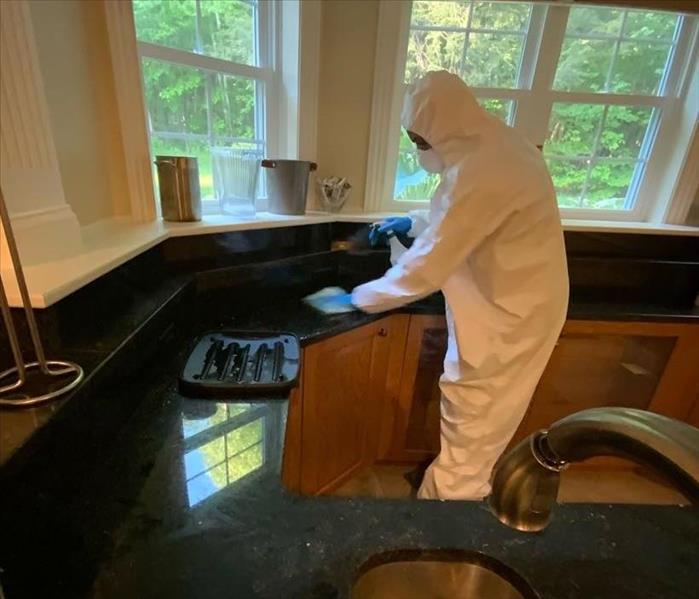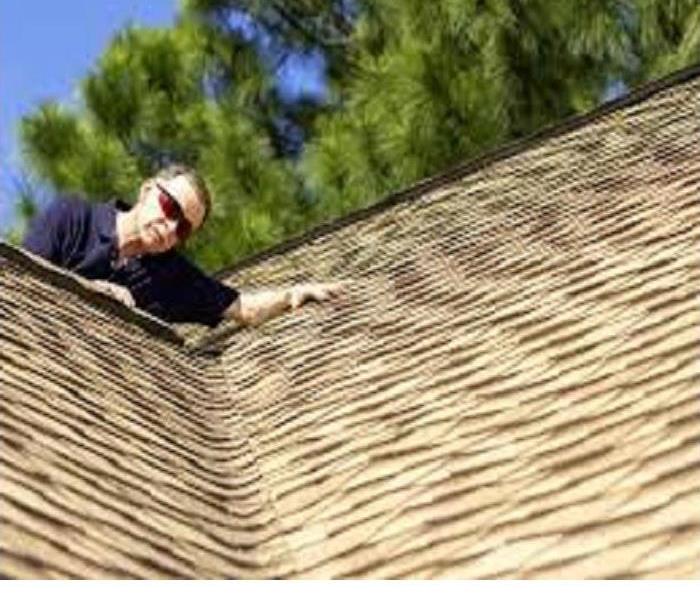Ensuring Sanitation: A Vital Step in Restoring Your Home After a Water Loss
5/28/2024 (Permalink)
 Proper sanitation helps eliminate moisture and removes any existing mold spores, preventing mold growth and further damage to your home.
Proper sanitation helps eliminate moisture and removes any existing mold spores, preventing mold growth and further damage to your home.
Water damage in your home can be a stressful experience, but restoring it to its preloss condition involves more than just drying out the affected areas. One critical aspect of the restoration process that often gets overlooked is sanitation. Proper sanitation is essential to ensure the safety and health of you and your family after a water loss. In this SERVPRO® blog post, we'll explore the importance of sanitation during home restoration after water damage and the steps involved in achieving a clean and healthy living environment.
Why Sanitation Matters:
Health Concerns: Standing water and moisture create the perfect breeding ground for bacteria, mold, and other pathogens. Without proper sanitation, these contaminants can pose serious health risks to occupants, leading to respiratory issues, allergies, and other health problems.
Preventing Mold Growth: Mold can begin to grow within 24 to 48 hours after water damage occurs. Proper sanitation helps eliminate moisture and removes any existing mold spores, preventing mold growth and further damage to your home.
Odor Removal: Water damage often leaves behind unpleasant odors caused by mold, mildew, and bacteria. Sanitizing the affected areas helps neutralize these odors, leaving your home smelling fresh and clean.
Steps for Sanitation During Home Restoration:
Safety Precautions: Before beginning the sanitation process, ensure that the area is safe to enter. Turn off electricity to prevent the risk of electrical shock, and wear personal protective equipment (PPE), such as gloves, masks, and goggles, to protect yourself from contaminants.
Thorough Cleaning: Use appropriate cleaning agents and disinfectants to clean all affected surfaces thoroughly. Pay special attention to areas that came into contact with contaminated water, such as floors, walls, and belongings.
Deodorization: Utilize specialized equipment and techniques to eliminate odors caused by water damage. This may include air scrubbers, ozone generators, or thermal fogging to neutralize odors at the molecular level.
Drying: Proper drying is crucial to prevent mold growth and maintain a healthy indoor environment. Use high-powered fans, dehumidifiers, and moisture meters to ensure that all moisture is removed from the affected areas.
Professional Assistance: While you can take certain sanitation measures on your own, it's essential to enlist the help of professional restoration experts like SERVPRO for thorough and effective sanitation. Our trained technicians have the expertise, experience, and specialized equipment to ensure that your home is properly sanitized and restored to a safe and healthy condition.
Conclusion:
Sanitation plays a critical role in the home restoration process after water damage. By prioritizing sanitation and following proper cleaning and disinfection procedures, you can ensure the safety and health of your family and protect your home from further damage. Remember, when in doubt, don't hesitate to contact SERVPRO for professional restoration services. We're here to help you every step of the way.
SERVPRO's Cleanup Services in Medford
3/29/2023 (Permalink)
 A neglected dwelling.
A neglected dwelling.
SERVPRO is a company that provides a wide range of restoration and cleanup services for both residential and commercial properties. Their services cover various types of damage caused by water, fire, mold, and other disasters. When it comes to cleanup, SERVPRO's trained technicians use specialized equipment and techniques to thoroughly clean and sanitize affected areas, ensuring that they are safe for occupancy.
Here are some of the cleanup services that SERVPRO provides:
Water Damage Cleanup: When a property suffers water damage, whether from a burst pipe or flooding, SERVPRO technicians will extract the water, dry out the affected area, and clean and sanitize all affected surfaces to prevent mold growth and other potential hazards.
Fire Damage Cleanup: In the event of a fire, SERVPRO will remove debris, clean up soot and smoke damage, and deodorize the affected area to eliminate any lingering smoke odor.
Mold Remediation: If mold is present in a property, SERVPRO will use specialized equipment to contain the affected area, remove the mold, and clean and sanitize all affected surfaces to prevent further growth.
Biohazard Cleanup: SERVPRO provides cleanup services for biohazardous materials, such as blood and bodily fluids, and other dangerous substances.
Carpet and Upholstery Cleaning: SERVPRO uses specialized equipment to thoroughly clean and sanitize carpets and upholstery, removing dirt, allergens, and other contaminants.
SERVPRO's cleanup services are designed to restore properties to their pre-damage condition and ensure that they are safe for occupancy. With their experienced technicians and specialized equipment, SERVPRO can handle any cleanup job, big or small.
Spring Home Maintenance Checklist
5/9/2017 (Permalink)
Give your home a complete physical—inside and out—to ready it for those warm-weather months ahead.
EXTERIOR INSPECTION
Roof. You don’t need to climb up there yourself; with binoculars and a keen eye, you can probably spot trouble. Do you see any shingle-shift, suggesting that some fasteners may have failed and need replacing? Any cracked or missing shingles? What about nail-pops? “We call them eyebrows,” Niles explains. “It’s when nails push the tabs of the shingles up, allowing water to get in where those nails are coming through.” All will need to be addressed to keep your roof at peak performance.
Chimneys. If you have a masonry chimney, check the joints between bricks or stones. Have any fallen out? Is there vegetation growing out of them? Each signals water infiltration. Also, look for efflorescence—”a white calcium-like deposit that indicates your masonry joints are no longer repelling water but absorbing it,” says Niles. Consider re-sealing masonry with a clear, impermeable or water-resistant barrier material (like Thoroseal products). Brush it on, small areas at a time; let it absorb for 15 minutes, then reapply—it may need a couple of applications.
Exterior Walls. Whether you have wood siding, stucco or brick, look for trouble spots, especially under eaves and near gutter downspouts. Water stains normally indicate that your gutters are not adequately containing roof runoff. If you have wood siding, check for openings, damaged areas or knots that have popped out, making way for carpenter ants, woodpeckers and other critters that may nest in or burrow through.
Foundations. When inspecting the exterior of your home, be sure to examine the foundation from top to bottom for masonry cracks. “Routine caulking by homeowners won’t do the job,” says Niles. “Hire a foundation specialist who can employ a two-part epoxy injection system that will bond cracks chemically,” he adds.
Windows. Leakage around windows will admit warm summer air and let cooled indoor air escape, so be sure to check that any caulking and weather stripping you have in place has remained intact. “A tight seal is the first line of defense against air and water,” says Marty Davis, marketing manager, Simonton Windows, Columbus, OH. If you experienced condensation inside the glass on double- or triple-glazed windows during the winter months, the weather seal has been compromised, and either the glass or the window will need to be replaced.
Spring-clean your windows—inside and out—with a store-bought or homemade window cleaner (one cup rubbing alcohol, one cup water and a tablespoon of white wine vinegar will work just fine) and either a squeegee or a soft cloth. Never use abrasive cleaners or a high-pressure spray washer. You don’t want to scratch the glass or crack the caulking around each unit. If screens were on all winter, remove and clean them with mild detergent. Lay them on a dry surface, like a driveway to air-dry before putting them back on. “Never power-wash screens,” urges Davis, “it could damage the mesh.”
INTERIOR MAINTENANCE
General Cleaning. Spring is a good time to clean areas of the house that often go neglected. Dust or vacuum chair rails, window casings, tops of wall-mounted cabinets and ceiling fans. Launder or dry-clean fabric draperies and use a damp cloth to clean wood and vinyl blinds. Vacuum upholstered furniture and mattresses and consider renting a carpet cleaner—anything you can do to remove settled dust, mites, and allergens will make for a cleaner, and healthier, home.
If you detect grease residue in the kitchen, consider washing cabinets, backsplashes and walls with warm water and mild detergent. The same is true in the bathroom, where soap residue and fluctuations in heat and humidity combine to create the perfect breeding ground for mold and mildew. While you’re cleaning tile, look for areas of worn or missing grout, as these may lead to more serious water damage if not repaired.
Air Conditioning. Just as you readied your furnace for fall, now is the time to make sure that air conditioning units are in good working order for the warmer months ahead. Change the filter, check hose connections for leaks, and make sure the drain pans are draining freely. In addition, vacuum any dust that has settled on the unit and connections; over time it can impact the air conditioner’s effectiveness. If you suspected problems with the efficiency or performance of the unit last summer, now is the time to call in a professional to check it out.
Attics. Search for signs that indicate insects and critters have colonized. Also, search aggressively for mold, which often takes the form of “gray or black blotches that look like staining,” according to Tim Gentry, vice president of technical services, DaVinci Roofscapes, Kansas City, KS. Proper insulation and good ventilation will deter mold growth in the attic, so take action now to prevent the problem from developing in the warmer months ahead.
Basements. The basement—prone to dampness and insects—must be part of any thorough seasonal maintenance effort. Dampness suggests higher than normal relative humidity, inadequate ventilation and the need for a dehumidifier. Check the base of poured-concrete walls. “Cracks start from the bottom up, not the top down,” Niles points out. “If there’s water penetration, it’ll show at the bottom of those cracks.” And be sure to use a flashlight to examine exposed framing. “If you see even a quarter-inch or so of tunneling on the wood,” says Niles, “call a pest control company immediately.”
Leaks. Spring is a good time to check for leaky faucets, clogged drains and sweaty pipes. Check under the kitchen and bathroom sink to make sure connections on pipes and hoses are properly sealed, and look for any wetness around the dishwasher that could signal an existing or potential problem. The same is true of your laundry room; check washer machine hoses for cracks, bulges or dampness. The same is true for hot water heaters, which may show sign of corrosion and leaks.
OUTDOORS
Lawns. Rake the lawn to remove any branches, debris and leaves that you might have missed in the fall; if left, they can suffocate the grass beneath. During the winter, soil compaction, along with chemical changes altering your soil’s PH, may have left your lawn vulnerable to weed growth and other issues. Even if you can’t see weeds, they are more than likely waiting for optimum conditions to propagate. If you want to prevent them from germinating, consider an organic herbicide; fertilizers are better suited to the fall.
Make sure outdoor water systems—pipes, faucets, and in-ground sprinkler systems—are in working order. Once the ground thaws completely, start preparing new garden beds for summer plants. And take stock of your garden tools and lawn-maintenance equipment, including lawn mowers, trimmers and hoses.
Decks and Patios. Look for warped, loose or splintered boards, and do a good sweep to remove any leaves and debris accumulated in the space between boards. “Whether it’s wood, plastic or composite, a deck should be cleaned every year to extend its life,” says Chuck Harris, owner, Custom Lumber Manufacturing Co., Dothan, AL. If the finish on your wood deck is faded or worn, now is the time to clean, stain, and reseal it. If you have composite decking, follow manufacturers’ recommendations on seasonal care. The same is true for wood and composite fences, pergolas, trellises and other structures. If you have a stone patio, a simple hose down provide be all the maintenance required (unless you detect moss or staining, in which case a more serious cleaning may be necessary).
Outdoor Furniture. If you stored your lawn furniture for the winter, bring it outdoors and give it a hose rinse, or wash it with a mild detergent. For metal furniture, check for signs of rust or paint erosion; a simple remedy of spray enamel will prevent further damage from sun, rain and humidity in the months ahead.
Grills. If your gas grill has remained idle over the winter months, check burner jets for clogs and obstructions, and be sure that gas hoses and connections are sound and secure. You’ll also want to check for propane. For charcoal grill owners, make certain your grill is clean of ash and free of grease residue. It’s a good habit to adopt throughout the grilling season, not just in the spring.
 Proper sanitation helps eliminate moisture and removes any existing mold spores, preventing mold growth and further damage to your home.
Proper sanitation helps eliminate moisture and removes any existing mold spores, preventing mold growth and further damage to your home.






 24/7 Emergency Service
24/7 Emergency Service

